Why Is The Internet of Things Important: Unveiling Its Importance In Our Connected World [2024]
The Internet of Things (IoT) is changing how we live by linking ordinary objects to the internet, enabling them to exchange data. This transformation is revolutionizing industries, improving our daily experiences, and laying the foundation for futuristic smart cities. But why is the Internet of Things important, and how does it operate? Our article below will provide the answers you seek.
Understanding Of IoT
In this section, we will initially help you understand the basic information about IoT, including what it is, how it operates, and its importance in daily life.
Introduction to the Internet of Things
The Internet of Things (IoT) is a groundbreaking technology that allows devices to communicate globally by exchanging data through the internet and reacting to it. While it may seem like a new idea to many, this interconnected system has actually been around for two decades.
From healthcare to aviation, traditional objects now possess digital intelligence. They’re able to transmit data autonomously, eliminating the need for human intervention. This fusion of the physical and digital realms is fueling automation and yielding valuable insights. It’s also propelling the development of smart infrastructure, revolutionizing industries, and introducing exciting personal gadgets.

Portrait of the Father of IoT: Exploring the Origins of the Term
Coined by Kevin Ashton in 1999, the term “IoT” conjures up a vision where objects aren’t merely static—they actively participate in a connected world. This vision continues to evolve, pushing the boundaries of technology and connectivity forward. As of present, 871 million smart home devices have been shipped worldwide, and this number is anticipated to surge to 1.23 billion by the year 2027. Additionally, a study conducted by Microsoft revealed that as of 2019, a remarkable 80% of major organizations had already begun incorporating IoT technology into their operational frameworks.
How Does IoT Work?
The Internet of Things works by linking smart devices over the internet. These devices are equipped with processors, sensors, and communication hardware. They collect, send, and respond to data from their environment. For example, in smart agriculture, IoT sensors track soil moisture and temperature. They send this information to a central system for analysis.
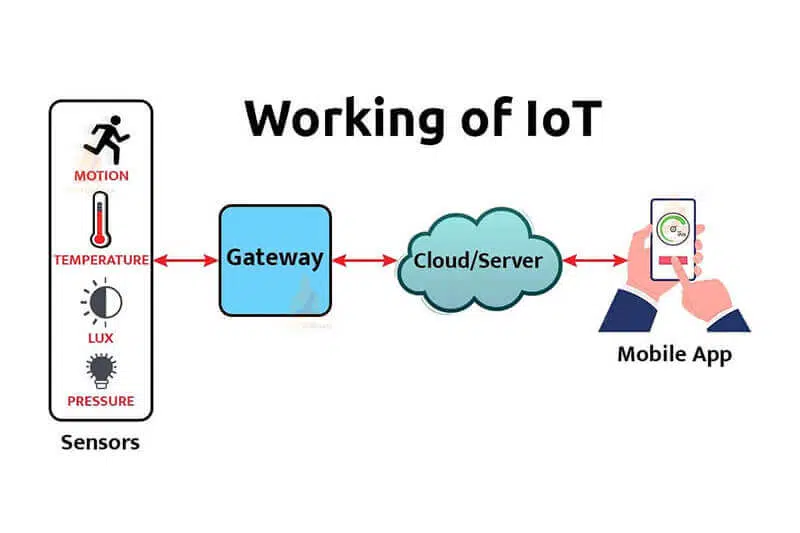
Example of IoT Application in Improving Quality of Life: Image Source – Techsparks
Additionally, IoT devices share collected data through connections to gateways or edge devices. This enables either cloud-based analysis or local processing. In situations like smart cities, interconnected IoT devices communicate with each other. They use real-time data exchanges to coordinate things like traffic flow.
Although IoT operates autonomously, users can still interact with devices. They can adjust settings or access the data generated. Overall, IoT relies on various connectivity, networking, and communication protocols. These are tailored to specific applications and often use artificial intelligence and machine learning to improve data collection efficiency and adaptability.
Looking For a Dedicated Team?
Are you seeking to revolutionize your manufacturing operations through cutting-edge Internet of Things services? Look to Savvycom for unparalleled expertise! With a distinguished track record spanning over 15 years in IoT development, Savvycom excels in delivering tailored IoT solutions tailored to the specific requirements of your industry. Join forces with us for top-tier IoT outsourcing companies, leveraging our position as one of Asia’s foremost IoT software outsourcing companies. Together, we can harness the transformative potential of IoT technology to optimize and fortify your manufacturing workflows. Let’s unite to elevate your operational efficacy and propel your enterprise towards unprecedented achievements!
Why Is the Internet of Things important?
The Internet of Things is hugely important because it can turn our everyday surroundings into smart, interconnected systems. IoT makes it possible for devices that were once passive to communicate and react in real-time, which makes things more efficient and convenient across different areas. It basically links up the physical and digital worlds, creating lots of opportunities and, of course, some challenges too.
Economically, adopting IoT helps businesses make more money and save costs by streamlining processes and predicting when maintenance is needed. Socially, IoT tackles big issues like healthcare, sustainability, and urbanization, which ultimately makes life better for everyone.
Looking ahead, it’s clear that IoT will keep evolving, driven by new tech and changes in the market. So, it’s a trend that’s here to stay, shaping the way we live and work.
Key Components Of The Internet Of Things
The Internet of Things operates thanks to several essential parts:
- IoT Devices: These are physical gadgets equipped with sensors or software to gather and share data. Think of industrial machines that monitor performance in real-time, fitness trackers keeping tabs on your health, or smart thermostats adjusting energy use.
- Connectivity: This is how devices talk to each other and exchange information. Whether it’s through Wi-Fi, Bluetooth, Zigbee, or cellular networks, there are various technologies that make this communication possible.
- IoT Platforms: These are like command centers for IoT data. They collect information from devices and offer tools to analyze and manage it. Big players in this field include Amazon’s AWS IoT and Microsoft’s Azure IoT.
- Data Storage and Analytics: Your IoT gadgets often send their data to the cloud, where smart algorithms analyze it. This analysis helps businesses figure out ways to improve their operations.
- Edge Computing: Instead of sending all the data to the cloud, some processing happens right where the data is generated. This speeds up response times and saves on bandwidth, which is super handy for things like medical devices and car safety systems.
- Security Systems: These are the digital locks and keys that keep your data safe. Encryption, strong passwords, and regular updates are all part of the game to keep hackers out and your information secure.
Together, these pieces form the backbone of the Internet of Things, making it possible for industries to tap into its potential.
Types Of Internet Of Things (IoT) Protocols
When it comes to making our devices in the Internet of Things world talk to each other seamlessly, IoT protocols are like the unsung heroes. They’re the ones responsible for ensuring smooth communication and data sharing between our gadgets and the central systems that manage them. Let’s take a closer look at some of the common ones:
- MQTT (Message Queuing Telemetry Transport): Think of MQTT as the lightweight champ. It’s great at saving bandwidth and getting data moving quickly within IoT networks.
- HTTP (Hypertext Transfer Protocol): You’ve probably heard of this one before. It’s the go-to for sharing data between IoT gadgets and servers. You’ll find it everywhere, from web apps to APIs.
- CoAP (Constrained Application Protocol): CoAP is the specialist for devices that have limited resources, like sensors and smartphones. It’s designed to keep communication efficient in these situations.
- AMQP (Advanced Message Queuing Protocol): AMQP is like the smooth operator of IoT messaging. It’s all about making sure different apps and software development services within the IoT world can talk to each other with ease.
- Bluetooth and Bluetooth Low Energy (BLE): These are the local heroes. They’re perfect for connecting gadgets nearby and for keeping an eye on them from afar.
Each protocol has its own strengths and weaknesses, so choosing the right one depends on what you need your IoT setup to do. But no matter which you pick, having the right protocol in place is key to keeping your IoT network running smoothly.
IoT Applications
To further reinforce the importance of IoT, let’s explore a typical example of its application for individuals and businesses.
IoT Applications for personal use
IoT applications have the potential to enhance individuals’ quality of life.
Smart home automation
IoT devices, like smart thermostats, lighting systems, locks, and plugs, let you control and automate your home from anywhere, making life simpler and more convenient. These nifty gadgets seamlessly fit into your daily routine, giving you easy control over various aspects of your household.
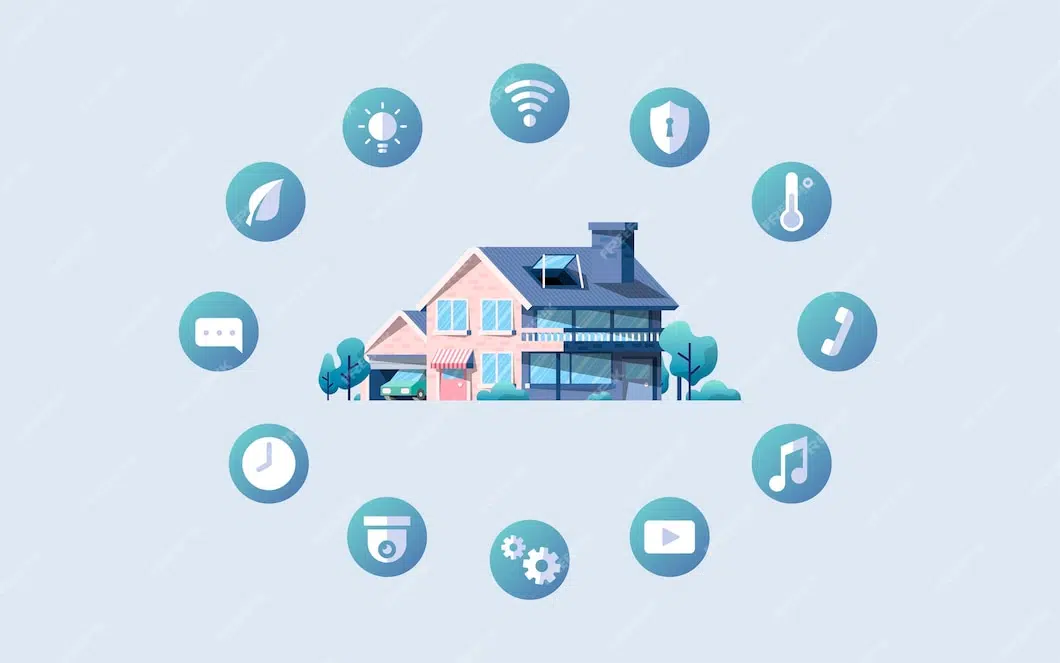
With just a phone, you can remotely control your home’s electrical appliances using IoT
Imagine adjusting your lights, security settings, and room temperature with just a voice command or a tap on your phone screen. Smart thermostats go even further by learning your habits and schedule, ensuring your comfort while saving energy. Security systems offer peace of mind with instant alerts and remote monitoring. With IoT, your home isn’t just a place to live—it’s an active part of your digital life, making your comfort and safety a top priority.
Health and fitness tracking
Wearable devices have transformed the landscape of health monitoring, offering continuous updates on vital metrics like heart rate, steps taken, and even sleep patterns. Ranging from smartwatches to fitness trackers, these gadgets employ sensors to keep tabs on essential signs and physical exertion. Thanks to IoT integration, they streamline data gathering and analysis, allowing users to stay informed about their health status in real-time.

All your health information will be checked in real-time and thoroughly analyzed
Furthermore, wearable IoT devices play a pivotal role in promoting healthier lifestyles by furnishing personalized insights and feedback on fitness endeavors. Whether it’s monitoring workout routines or tracking progress, these devices empower individuals to make well-informed choices regarding their health and overall well-being.
Smart personal assistants
Smart Personal Assistants like Amazon Alexa, IOS Siri and Google Assistant are crucial components of IoT ecosystems, effortlessly connecting with a variety of smart home devices. They provide users with the convenience of controlling IoT gadgets using simple voice commands, enhancing the efficiency and connectivity of modern living spaces.

Siri is consistently rated as the top IoT project among smart personal assistants – Image source: Apple
As the popularity of voice assistant-enabled devices grows, from smartphones to smart speakers, so does the adoption of voice-controlled IoT solutions. Moving forward, the seamless integration of voice assistants with IoT devices will reshape how we interact with and manage our connected environments. Amazon Alexa and Google Assistant operate via cloud-based systems, showcasing the harmonious relationship between virtual assistants and IoT consumer products.
IoT Applications for Business
Below are typical applications of IoT in businesses.
Supply chain management
First off, the Internet of Things has the potential to completely transform how supply chains are managed. When companies integrate IoT devices, they gain an incredible ability to track their products in real-time. This not only makes operations smoother but also makes the entire supply chain more dependable. With smart sensors built into these devices, businesses get instant updates on where their shipments are and their condition. This helps them tweak delivery schedules on the fly and gives stakeholders peace of mind.
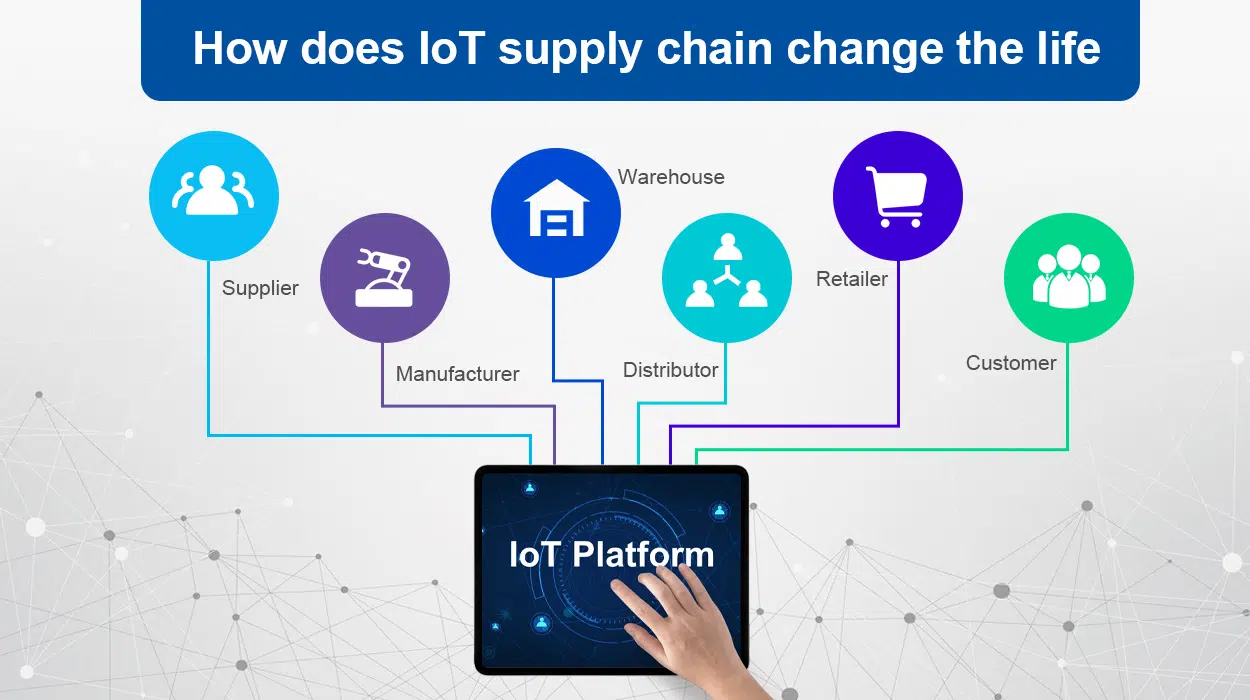
IoT is a powerful assistant when applied to supply chain management – Image source: Mokosmart
In addition, IoT doesn’t just stop at tracking. It’s proactive about maintenance too, sending out alerts before issues become big problems. This means companies can fix things before they cause disruptions, keeping operations running smoothly and customers happy with on-time deliveries. And beyond just keeping an eye on things, IoT’s predictive maintenance features also cut down on downtime and make machinery last longer, saving both time and money.
Industrial IoT (IIoT)
Next, let’s talk about the Industrial Internet of Things, which marks a significant shift in manufacturing. With IIoT, factories become smarter thanks to interconnected devices. These specialized IoT tools automate and optimize operations using sensors and instruments that work alongside industrial computer systems. By monitoring machinery in real-time, operators can quickly adapt to changes, preventing breakdowns and keeping productivity high. IIoT platforms act as central hubs for collecting and analyzing data, helping businesses make informed decisions and improve efficiency through predictive maintenance.
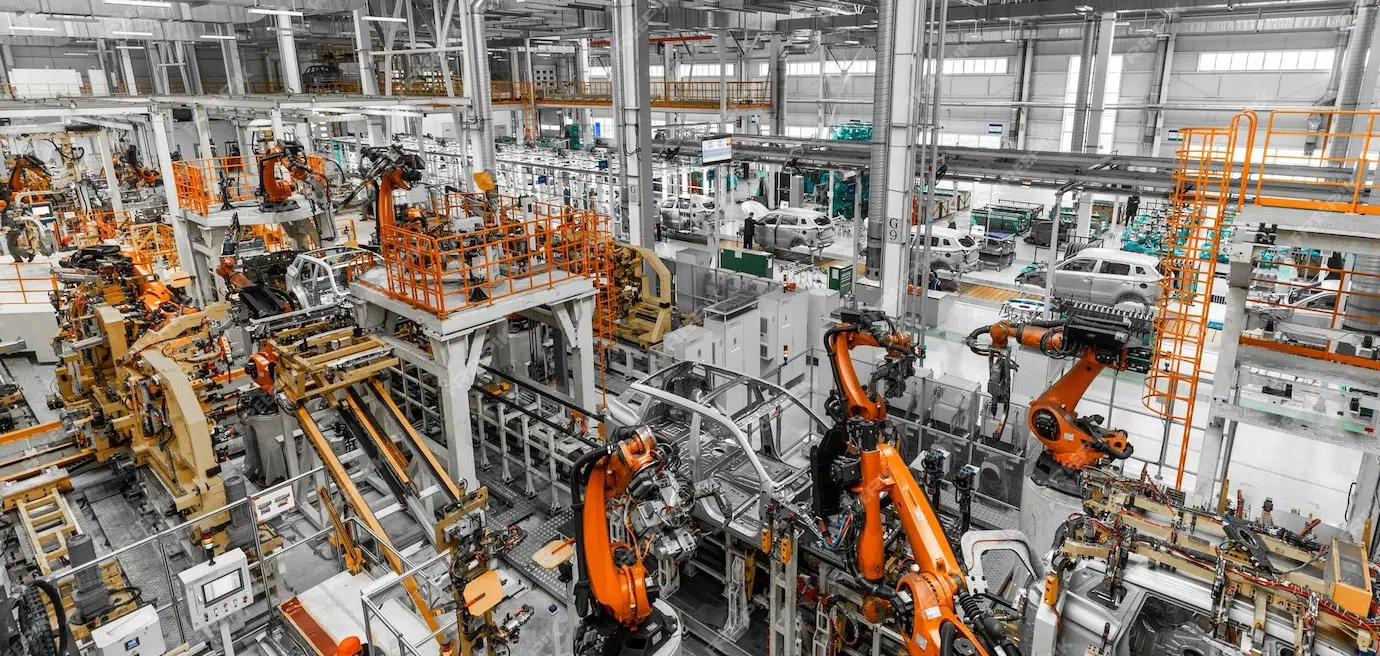
Applying IoT in the automobile manufacturing industry helps reduce time while ensuring accuracy
But IIoT’s impact goes beyond just controlling operations. It’s a driving force behind resource optimization, safer working environments, and increased productivity. Adopting IIoT practices also promotes sustainability, fosters employee skills, and advances the concept of smart factories. In essence, IIoT isn’t just about upgrading technology—it’s a strategic tool that propels the manufacturing industry towards a smarter and more adaptable future.
Healthcare
Lastly, in IoT Applications for Business that cannot be ignored is Healthcare, the healthcare field is undergoing a major makeover thanks to the integration of the Internet of Things, which brings in new and exciting ways to improve patient care. IoT gadgets are essential for letting doctors keep an eye on patients remotely, providing them with real-time updates for personalized and prompt medical attention. Take wearable devices like heart rate monitors and glucose meters, for example. They’re now hooked up to the internet, making it possible to continuously monitor vital health stats. This constant watch helps medical staff maintain precise patient records, ensuring they’re on top of things and ready to act swiftly.

IoT applications in healthcare have elevated this industry to new heights
In emergencies, the impact of IoT is even more obvious. Ambulances equipped with connected devices can send patient info to hospitals as they rush there, making the transition from emergency response to hospital care smoother. This seamless communication can literally save lives, as hospital teams can prepare to treat patients as soon as they arrive. The biggest advantage of IoT in healthcare is how it enhances the quality of care by bridging the gap between patients and healthcare providers. This means medical equipment is used efficiently and patients receive the right care at the right time, with all the necessary info at hand.
Internet Of Things Security Concerns
Undoubtedly, the advent of the Internet of Things brings forth a myriad of advantages. However, alongside these benefits lurk potential security threats. As we integrate more devices into the internet, the scope for vulnerabilities widens. The rising prevalence of interconnected devices has propelled concerns regarding IoT security and privacy into the spotlight.
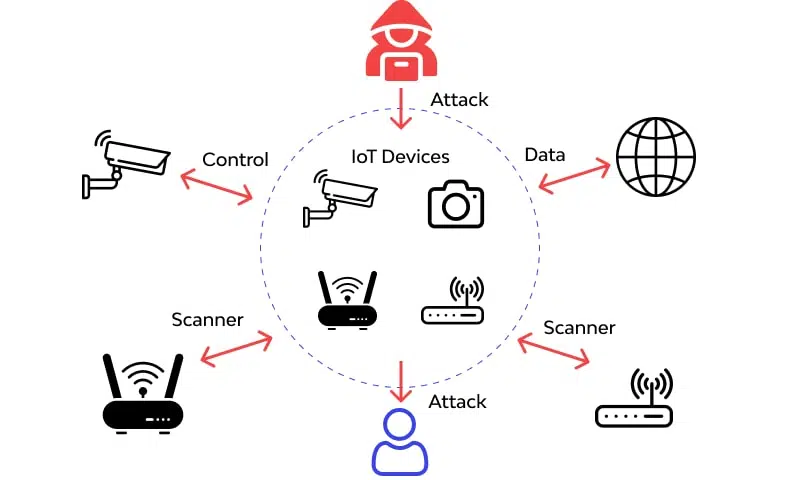
Visualizing the Overview: How Hackers Attack IoT Networks
The distinctive architecture of IoT networks, characterized by a multitude of connected devices serving various purposes, poses formidable challenges in implementing effective security measures. Breaches in IoT devices could lead to unauthorized access, data breaches, and even jeopardize critical infrastructure. Moreover, the sheer volume of personal and sensitive data collected and transmitted raises red flags regarding privacy and data protection.
Key issues like data ownership, consent, and secure data handling practices have emerged as central topics in discussions concerning IoT security and privacy. Addressing these concerns necessitates a holistic approach. This approach should encompass robust encryption techniques, authentication mechanisms, regular software updates, and strict adherence to privacy regulations. Such measures are imperative to safeguard the confidentiality, integrity, and privacy of IoT systems and the data they manage.
Where To Find Internet Of Things Outsourcing
Navigating the IoT landscape can be complex, especially for businesses without in-house expertise. That’s where partnering with specialized service providers becomes crucial. Internet of things outsourcing like Savvycom excel in developing, deploying, and maintaining Internet of things solutions tailored to specific industry needs.
If you’re a business itching to dive into IoT but feeling a bit out of your depth, outsourcing to pros like Savvycom is a savvy move. They don’t just offer off-the-shelf solutions; they custom-make them to fit your requirements like a glove, reducing the risks that come with IoT deployments.
As the IoT journey unfolds, being proactive is key. Both service providers and businesses need to roll up their sleeves and take the necessary steps to protect sensitive data and keep interconnected systems running smoothly. By teaming up with trusted partners, you can confidently navigate the IoT terrain and stay ahead of the game.
Conclusion
The Internet of Things (IoT) is an intriguing area that broadens the scope of connectivity and enhances our interaction with the world around us. As IoT expands, it increasingly becomes a fundamental aspect of daily life, sparking innovation and presenting fresh avenues for personal and business applications. Proficiency in utilizing IoT can yield substantial benefits; however, it is crucial to handle this technology with care, particularly concerning security considerations. By adopting a strategic approach and implementing IoT effectively, we pave the way for a future that is characterized by enhanced efficiency, sustainability, and interconnectedness.
Savvycom – Your Trusted Tech Partner!
Revolutionize Manufacturing with Innovative IoT Solutions from Savvycom, Asia’s Premier IT Outsourcing Provider, at the forefront of digital transformation since 2009. Leveraging our deep expertise, we excel in crafting state-of-the-art IoT solutions tailored precisely to your needs. Whether it’s streamlining production lines, enhancing equipment efficiency, or enabling real-time data analytics, we deliver holistic solutions to propel manufacturing into the future. Collaborate with us to unlock the potential of IoT technology and spearhead innovation across your industry.
Embark on a Manufacturing Revolution Today! Partner with Savvycom, Asia’s Leading IT consulting service, and Transform Your Industry with Cutting-Edge IoT Solutions. Let’s Ignite Innovation Together!
Savvycom is right where you need. Contact us now for further consultation:
- Phone: +84 24 3202 9222
- Hotline: +84 352 287 866 (VN)
- Email: [email protected]


